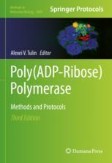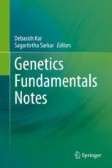Search
Search Results
-
Heterochromatic patterns of Citrus revisited: a new look at species origins and karyotype evolution
Most Citrus L. ‘species’ have arisen through reticulated evolution, resulting in many hybrid species with constant chromosome number (2 n = 18) and...

-
Interplay of pericentromeric genome organization and chromatin landscape regulates the expression of Drosophila melanogaster heterochromatic genes
BackgroundTranscription of genes residing within constitutive heterochromatin is paradoxical to the tenets of epigenetic code. The regulatory...

-
Study of the Association of Ouib and Nom with Heterochromatin in Drosophila melanogaster
AbstractIn Drosophila , a large group of actively transcribed genes is located in pericentromeric heterochromatin. It is assumed that heterochromatic...

-
Cytogenetic characterization of Austroplebeia australis: evolutionary hints from a stingless bee outside the Neotropical region
Cytogenetic data on stingless bees outside the Neotropical region are still scarce, with chromosome numbers known for only a handful of species,...

-
Otu and Rif1 Double Mutant Enables Analysis of Satellite DNA in Polytene Chromosomes of Ovarian Germ Cells in Drosophila melanogaster
AbstractPolytene chromosomes in Drosophila serve as a classical model for cytogenetic studies. However, heterochromatic regions of chromosomes are...

-
Generating PARP Knockout D. melanogaster with CRISPR/Cas9 System
Long-branched negatively charged poly(ADP-ribose) (pADPr) is a posttranslation modification of nuclear proteins that play a key role in many...
-
High Level of Gene Transcription at the Embryonic Stage Leads to the Suppression of Heterochromatic Trans-Inactivation in Drosophila melanogaster Adults
AbstractIn some cases, gene transfer from euchromatin to constitutive heterochromatin as a result of chromosomal rearrangement is accompanied by...

-
Loss of chromatin remodeler DDM1 causes segregation distortion in Arabidopsis thaliana
Main conclusionIn ddm1 mutants, the DNA methylation is primarily affected in the heterochromatic region of the chromosomes, which is associated with...

-
Transmembrane nuclease NUMEN/ENDOD1 regulates DNA repair pathway choice at the nuclear periphery
Proper repair of DNA damage lesions is essential to maintaining genome integrity and preventing the development of human diseases, including cancer....

-
The proper interplay between the expression of Spo11 splice isoforms and the structure of the pseudoautosomal region promotes XY chromosomes recombination
XY chromosome missegregation is relatively common in humans and can lead to sterility or the generation of aneuploid spermatozoa. A leading cause of...

-
New patterns of polymorphism in the karyotypic analysis of the genus Plebeia (Hymenoptera, Apidae)
Plebeia is a taxonomically complex genus of stingless bees characterized by remarkable interspecific morphological similarity. On the other hand,...

-
Regulatory roles of nucleolus organizer region-derived long non-coding RNAs
The nucleolus is the largest sub-nuclear domain, serving primarily as the place for ribosome biogenesis. A delicately regulated function of the...

-
Genome wide inherited modifications of the tomato epigenome by trans-activated bacterial CG methyltransferase
BackgroundEpigenetic variation is mediated by epigenetic marks such as DNA methylation occurring in all cytosine contexts in plants. CG methylation...

-
Massive expansion of sex-specific SNPs, transposon-related elements, and neocentromere formation shape the young W-chromosome from the mosquitofish Gambusia affinis
BackgroundThe Western mosquitofish, Gambusia affinis , is a model for sex chromosome organization and evolution of female heterogamety. We previously...

-
Cytogenetic Analysis of Two Species of Brachyhypopomus (Hypopomidae): New Inferences about Karyotypic Diversification of Grass Knifefish
AbstractAmong the bluntnose knifefish of the Hypopomidae family, Brachyhypopomus is the most specious genus, with 28 species widespread in...

-
Evolutionary convergence or homology? Comparative cytogenomics of Caesalpinia group species (Leguminosae) reveals diversification in the pericentromeric heterochromatic composition
Main conclusionWe demonstrated by cytogenomic analysis that the proximal heterochromatin of the Northeast Brazilian species of Caesalpinia group is...

-
Locus-specific induction of gene expression from heterochromatin loci during cellular senescence
Senescence is a fate-determined state, accompanied by reorganization of heterochromatin. Although lineage-appropriate genes can be temporarily...

-
Single-molecule targeted accessibility and methylation sequencing of centromeres, telomeres and rDNAs in Arabidopsis
The short read-length of next-generation sequencing makes it challenging to characterize highly repetitive regions (HRRs) such as centromeres,...

-
Multiple distinct domains of human XIST are required to coordinate gene silencing and subsequent heterochromatin formation
BackgroundMammalian dosage compensation is achieved by the inactivation of one X chromosome in XX individuals. In eutheria this process is initiated...

-
Chromosomal Organization of DNA
In this chapter, we will understand how the ginormous amount of genetic information is packaged in a cell to not only be accommodated in a limited...
